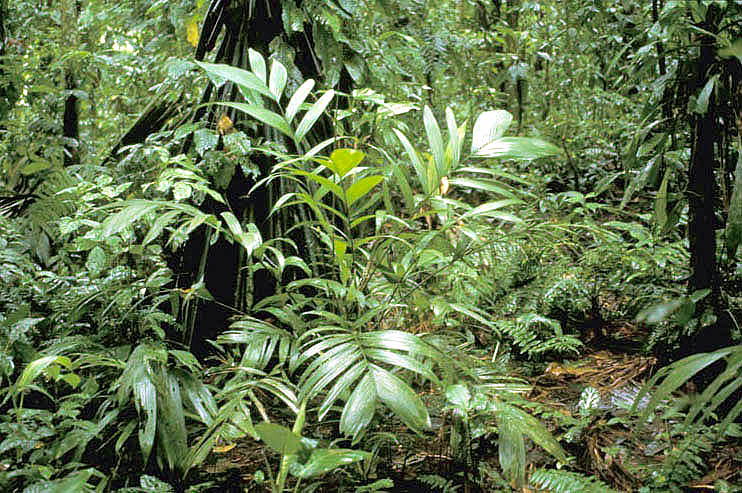Geonoma macrostachys var. macrostachys
Morphology:
Leaf blade irregularly to nearly regularly divided with up to 8 usually conspicuously sigmoid segments on each side; veins forming an angle of 40-60° with the leaf axis, never raised above; petiole approximately of the same length as the blade. Peduncle 80-150 cm long; spike 4-20 cm long and 4-7 mm in diameter, usually with densely positioned flower pits.
Distribution:
Western Amazon region.
Common, but usually not very abundant, in E Ecuador.
Notes:
A polymorphic variety, whose morphological variation is incompletely understood.
Common
names:
Arma ilu panga
–
Quichua
(C. Ceron #6678).
Dadu
–
Siona
(H. Balslev #4326 and additional references).
Guacamaya-panga
–
Quichua
(H. Balslev #4569).
Guacu maya
–
(P.J. Grubb #1509).
Huan-só-dé-dé
–
Secoya
(H. Balslev #4825).
K´ofahe
–
Cofán
(H.V. Pinkley #23 and additional references).
Naya-huë-dadu
–
Siona
(H. Balslev #4372).
O-có-pui
–
Secoya
(H. Balslev #4825).
Pa-í
–
Secoya
(H. Balslev #4826).
Yija-dére
–
Siona
(H. Balslev #4325).
Uses:
Fruits are eaten by the trumpeter bird, Sophia crepitans
(H. Balslev #62063).
Leaves are used for thatch
(H. Balslev #4326 and additional references).
Leaves are used to cover freshly hunted meat
(H. Balslev #62063).
The palm heart is used to kill witches: to make the poison, the palm heart is boiled along with other plants and hair and nails from the person killed by the witch
(H. Balslev #4825).
|
Latest posts by admin (see all)
- Aluminium Rattan Garden Furniture Design Ideas - September 11, 2019
- Popular Gardens and Parks in Sheffield, United Kingdom - September 18, 2018
- How New Eco-Friendly Garden Benches Help Plants and Consumers in the UK - February 26, 2018




Discussion: